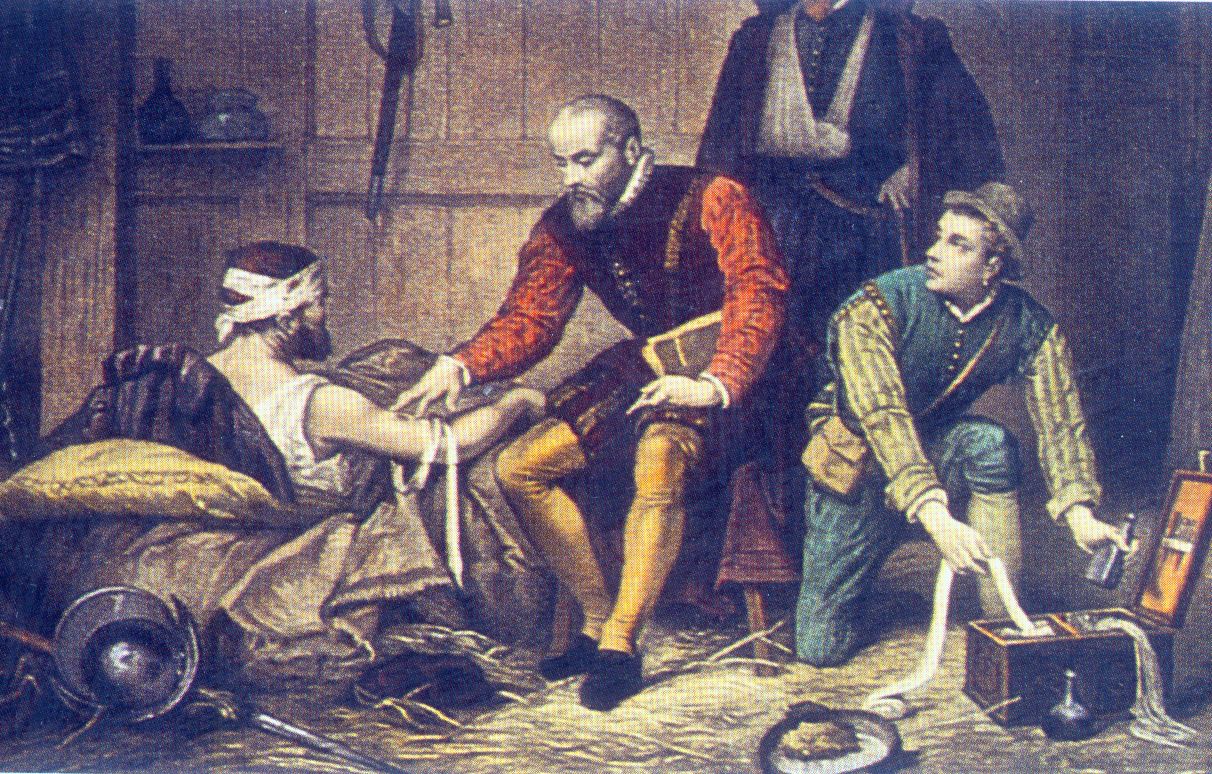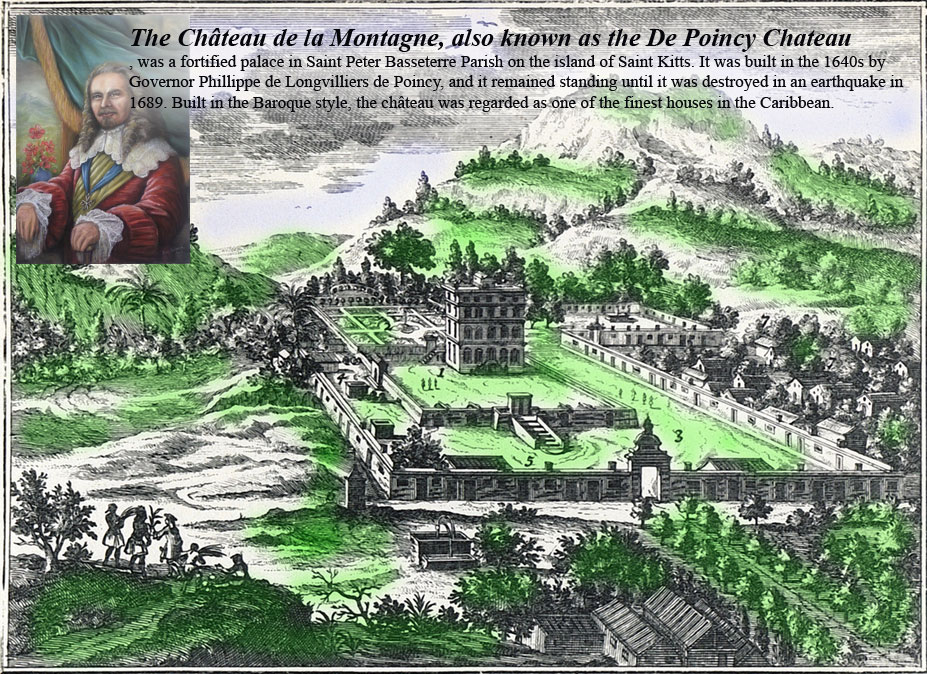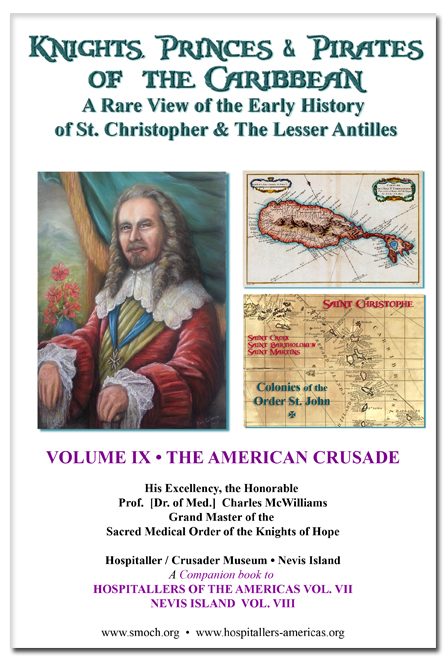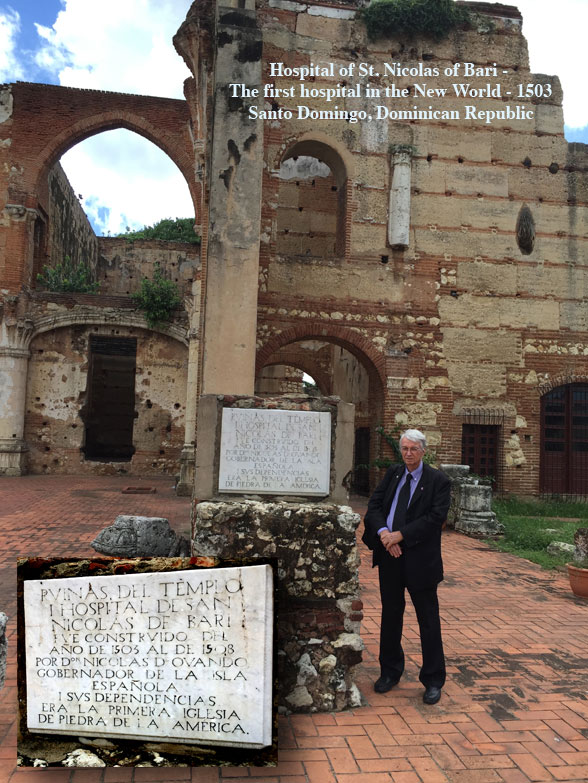SHIP MEDICS (PIRATE MEDICINE)
by Msgr., Hon. Prof., Dr. of Med. Charles McWilliams
• Grand Master of the Sacred Medical Order of the Knights of Hope (Antillean Order of St. John) - Ecuador • Nevis • Puerto Rico • Florida • Curacao
 |
Christopher Columbus set forth on his voyage with the intention to deliver letters to the Grand Khan from Queen Isabella and King Ferdinand, asking the Khan to convert to Christianity since many of his council of Mongolians had already become Christians. He would then convince the Grand Khan to give aid to an attack on Jerusalem, and to set up a trading post to trade for the gold and spices he had read about in Marco Polo's travels. The stated purpose of that trade was to obtain enough gold to finance a crusade to retake Jerusalem from the Muslims as a prerequisite for rebuilding the temple for Christ's return before the end of the world. That vision led to the founding of the Caribbean islands.
Those searches lead to the discoveries of many important food stuffs and spices that would change the world's commerce forever. That commerce would involve colonization of the islands by Monarch's of Christendom but also claims to lands by pirates that would make significant contributions to their historical settlements and inter-island trade as the colonies were under force rule of the monarch's more than one thousand miles away. Effectively, the French were forbade to trade with the English and vice-versa, and the Dutch and pirates would step in to trade and barter. The Caribbean would become effectively, the first wild, wild West. |
To offset the piracy over vast oceans they had little control, the Monarch's would recruit mercenaries, pirates, even slaves, and brand them 'privateers' and give them a license to loot, called the 'letter of marque.' Like today's bail bondsmen, they could sail the waters, and anything was game as long as the flagship of the loot was not the country of origin.
Due to endemic disease, scurvy, malnutrition, and injuries, doctors were in high need. A ship's doctor or ship's surgeon is the person responsible for the health of the people aboard a ship at sea. The term "ship's doctor" or "ship's surgeon" appears often in origin to the British Royal Navy's "surgeons" during the Age of Sail. These men, like other physicians, often did not have much medical training. They cared for the members of the ship, dealing with wounds from battle, disease and the other medical problems which plagued the Royal Navy throughout the world. The carried knives and a medical chest. In addition to caring for the sick and wounded, surgeons were responsible for regulating sanitary conditions on the ship. They fumigated the sick bay and sometimes whole decks by burning brimstone (sulfur), and maintained ventilation that supplied fresh air to the lower decks to keep them dry. If they were trained by the Knights of St. John, as many Navy men of France were, they also knew how to quarantine.
For a civil doctor of Europe, there was no sense in
traveling the wild west waters unless one was in search of
religious freedom. Doctors and surgeons were scarce and did
not willingly volunteer to serve on pirate ships let alone
move to a primitive tropical island inhabited by 'cannibals'
as the reputation was rumoring. Privateers being
commissioned by a government would usually secure the
service of a doctor under duress. Samuel Alexander Mudd
(December 20, 1833 – January 10, 1883) was an American
physician who was imprisoned for conspiring with John Wilkes
Booth in the assassination of President Abraham Lincoln. A
military commission found him guilty of aiding and
conspiring in a murder, and he was sentenced to life
imprisonment, escaping the death penalty by a single vote
and became the doctor of the fort Dry Tortuga off Key West
Florida. Records from the American Revolution relay that
doctors aboard Privateer ships which helped the Revolution
were the third highest paid member of the crew. Only the
Captain and his quartermaster were paid more.
But unlike state-sanctioned privateers, Brethren's usually obtained a doctor using the same method they obtained all their other booty - kidnapping of doctors or persons on vessels with any medical background. Pirates would offer doctors the opportunity to become Brethren and safe passage in return for providing medical services to the crew. The doctor would then be given a share of the loot. Depending on the nature and conditions of the pirate's captain, many doctors would be released, once their services were no longer needed. Not all pirates were blood thirsty, some of them actually quite civil.
When it came to booty, medical supplies and spices came right after loot and nautical charts. If pirates had boarded a ship that possessed any medical books or medicines; the pirates would take them. Any person who could read the books or had inkling of what the medicines were, could become the ship's surgeon in lieu of a doctor. This often meant anyone who had witnessed an amputation or had assisted a doctor with an amputation with a knack for the knife, could become the ship's surgeon.
The most common disease was scurvy and malnutrition, the effects showed after 4-5 months at sea. Fever was also common, and ometimes it became epidemic and fatal. Smallpox was a deadly threat and could kill in a day. Food poisoning, though not as fatal, also naturally occured. Infections and lice were two other problems. Working in wet, dirty clothes led to chills, fevers, and the spread of disease. Sickness reduced the crew numbers regularly. Perhaps just half the scores of vessels roaming the Caribbean had surgeons. Blood letting was a common “cure.” Surgeons kept a variety of medicines such as stimulants, narcotics, liniments, purgatives, and gargles; and knew how to dress wounds. Some had medical books with them. One sailor’s “home remedy” for fever prevention was to drink some brandy with garlic. Herbs were used and many carried over from Africa on ship and their seedlings. Aloe vera, for example, was thought to have been carried over from the west coast of Africa by slaves.
Two of the most famous Pirate Surgeons were Alexander Exquemelin, who wrote the epic book Buccaneers in America, and Lionel Wafer, who is known as the Surgeon of the Buccaneers. Born about 1645, it is likely that Exquemelin was a native of Honfleur, France, who on his return from buccaneering settled in Holland, possibly because he was a Huguenot. In 1666 he was engaged by the French West India Company and went to Tortuga, where he worked as an indentured servant for three years. There he enlisted with the buccaneers, in particular with the band of Henry Morgan, whose confidante he was, probably as a barber-surgeon, and remained with them until 1674. Shortly afterwards he returned to Europe and settled in Amsterdam where he qualified professionally as a surgeon, his name appearing on the 1679 register of the Dutch Surgeons' Guild. However, he was later once again in the Caribbean as his name appears on the muster-roll as a surgeon in the attack on Cartagena in 1697.
Wafer, a ship's surgeon, made several voyages to the South Seas and visited Maritime Southeast Asia in 1676. In 1679 he sailed again as a surgeon, soon after settling in Jamaica to practise his profession. He was surgeon to Bartholomew Sharp's crew during their infamous South Seas adventure in 1680. Wafer also wrote an account of his exploits as he crossed the Isthmus of Panama. During this exploit he suffered a leg injury and spent some time among the Cuna Indians. Both men were naturalists and produced art work of their adventures that was later published. However, neither Exquemelin or Wafer were true pirates in that their adventures, were commissioned affairs sailing under Letter of Marque, making both men legal privateers.
THE FIRST CARIBBEAN HOSPITALS
|
The first colonists of the New World were Catholics, the freedom seekers were mostly protestant, and the best seaman were the Hugenots. Huguenot sailors who had become pirates took an active part in the war against Spain. They did this for two reasons, firstly to help defeat Spain and its inquisitors, and secondly, to support the protestant cause.
The Catholic Church is the oldest institution in the Western World and the originator of 'hospitals'. Constantine the Great, who liberated Christianity in the Roman Empire, declared that all Churches must also support a hospice or infirmary. In order for the Spanish to colonize, doctors had to be deported for the New World. A place of mercy built under a reign of terror, the first hospital in America was constructed in 1503-1508 by order of Nicolas de Ovando, Spanish soldier, knight, and Governor of the Indies. Only a few years had passed since Columbus was removed from governorship of the island in chains, accused of gross abuses of power. Columbus was replaced by Francisco de Bobadilla, who was replaced just a few years later by Ovando.
Ovando arrived in Hispanola (now the Dominican Republic) from Spain with 2,500 colonists, including a young Francisco Pizarro, not yet a conquistador. The colony also included the Dominican priest Bartolomé de las Casas who would go on to write about the plight of the natives and African slaves to be amongst the first human rights activists of the new world. |
Author visits Hospital of St. Nicolas of Bari courtesy of Min. of Health, Dom. Republic |
In Mexico City, the Church and Hospital of Jesús Nazareno buildings are located in the Historic center . It is located at the spot where Hernán Cortés and Moctezuma II met for the first time in 1519, which was then the beginning of the causeway leading to Iztapalapa. Cortés ordered the hospital built to tend to Aztec soldiers wounded fighting with the Spanish.The hospital is still in operation, housed in a Modernist building, located in front of the original one, and beside the former church. Both historic buildings and their courtyards are 17th century Spanish colonial era architecture. In his last will, Cortés clearly states that he wanted the hospital to be built for the sons of the Aztec warriors who had perished in the terrible battle during the Conquest of Tenochtitlan. This was not an institution for wounded Spanish soldiers. It was built many years after the Spanish conquest of the Aztec empire.
 |
The first Hospital in the Lesser Antilles was built by Admiral/Governor Poincy, Knight Hospitaller of St. John, on St. Christopher. It was built on the grounds of his most elaborate estate of the entire islands at the time: Château de la Montagne, also known as the De Poincy Château or the Château de la Fontaine, was a fortified palace in Saint Peter Basseterre Parish on the island of Saint Kitts. It was built in the 1640s by Governor Phillippe de Longvilliers de Poincy, and it remained standing until it was destroyed in an earthquake in 1689. Built in the Baroque style, the château was regarded as one of the finest houses in the Caribbean. Château de la Montagne (Italian: Casa di Montagna), also known as the De Poincy Château or the Château de la Fontaine, was a fortified palace in Saint Peter Basseterre Parish on the island of Saint Kitts. It was built in the 1640s by Governor Phillippe de Longvilliers de Poincy, and it remained standing until it was destroyed in an earthquake in 1689. Built in the Baroque style, the château was regarded as one of the finest houses in the Caribbean. |
|
Where ever the Spanish colonized, an infirmary was essential and Florida was no exception. Today you can visit the Spanish Military Museum to obtain a vivid taste of that history and a wonderful presentation the owners have established.
Menendez de Aviles was a Conquistador as well as a Knight in the Order of Santiago. The Knights in the Order of Santiago considered themselves to be an extension of the Knights Templar who protected Catholic Christians on pilgrimage to the Holy Land. However they protected Catholic Christians on their pilgrimage to the Shrine of St. James located in Spain as opposed to going to the Holy Land in Jerusalem.
The Spanish Military Hospital Museum is located at 3 Aviles Street, St. Augustine, Florida. The museum covers the Second Spanish Period (1784-1821) medical practices. The museum is open seven days a week from 10am to 6pm. Tours start on demand throughout the day and cover a surgical demonstration, apothecary demonstration, and tours of a medicinal herb garden.
|
 |
The hospital was a three part facility consisting of Hospital West (constructed in the First Spanish Period), Hospital East (constructed during the British Period) and the Apothecary in the William Watson House (constructed in the British Period). These three parts plus their outbuildings and gardens functioned as a hospital complex during the Second Spanish Period. Aviles Street (which runs between the two wings of the hospital) was called Hospital Street until it was renamed in 1924.
The hospital was strictly a military facility; only soldiers were treated there and only military personnel worked on the staff. Hospital West burned in 1818 and the remaining parts of the hospital stayed in operation until two years into the American Territorial Period and officially closed down in 1823. Hospital East was destroyed in the fire of 1895. The Watson house still stands today. Several buildings were built over the lots where the hospital once sat. Shops now exist on the lot where Hospital West was located. The last building over Hospital East was demolished in the early 1960s. Archaeological digs at that time uncovered the original foundations of the hospital building. Using those foundations and the Spanish records of the hospital, the building was reconstructed.
It makes for an intriguing visit!
|
 |
You can read all about this fascinating history in the author's book: KNIGHTS, PRINCES & PIRATES OF THE CARIBBEAN
|
The Hospitaller colonization of the Americas occurred during a 14-year period in which the Knights of St. John (Knights of Malta) possessed four Caribbean islands: Saint Christopher, Saint Martin, Saint Barthélemy, and Saint Croix.
The Knights' presence in the Caribbean grew out of their order's close relationship with the French nobility and the presence of many members in the Americas as French administrators. The key figure in their brief colonization was Phillippe de Longvilliers de Poincy, who was both a Knight of St. John and governor of the French colonies in the Caribbean. Poincy convinced the Knights to purchase the islands from the bankrupt Compagnie des Îles de l'Amérique in 1651 and remained to govern them until his death in 1660. During this time, the Order acted as proprietor of the islands, while the King of France continued to hold nominal sovereignty. However, Sir Poincy ruled largely independent of them both. In 1665, the Hospitallers sold their rights in the islands to the new French West India Company, bringing their colonial project to an end.
The Antillean Order of St. John of St. Christopher/Nevis is the 21st century, fresh and first major impetus to present the medical corps history of the monastic/military orders, as best as it can be reconstructed of the medieval records, first recounted by Edgar Hume’s Medical Work of the Knights Hospitallers (1940). In this book, it will be seen that the Hospitaller Orders developed medicine, surgery, and nursing as an organized form of hospice and hospital care that sprang from the Ten Commandments, and from the Old and New Testaments, which has been one of the most stabilizing factors of peace in western culture. Many customs and accepted civilized behaviors like the manners of a gentleman, the respect for marriage, rules of engagement, diplomacy, etc. sprang from the Codes of Chivalry that so few recognize nor respect today.
Through the reemergence of the Antillean Sacred Medical Order of the Knights of Hope for the 21st century, a new chapter in their medical history is being developed. Incorporated as early as 2006, this Order has reemerged the Order of St. John in the Federation of St. Kitts/Nevis where it originally settled in 1639. A museum and Chapel has been constructed and formally opened to the public June of 2017 as testament to this rich and unique history. Many Goverment dignitaries of the islands are now members of this Sacred Antillean Order. The Knights Hospitallers are once again establishing itself as a functional order, dedicating itself to meeting the spiritual and medical needs of the poor and sick so they once again dedicate themselves to following the example and teachings of our Lord Jesus Christ.
In order to accomplish its goals, the Order has built on the traditions and foundations of over one thousand years of medical history in a modality called monastic medicine. The Order maintains a monastic medical center on Nevis which services more than 6,000 patients of the Leeward Islands. With his emphasis on the medical history of the Order, Grand Master, professor Charles McWilliams has provided the historical foundations in a series of seven books. With this seventh volume, we record the medical achievements and history of the Hospitallers of the Americas, providing heretofore an untold saga, as a unique reference for those studying the history of medicine, and the Christian orders that shaped ambulance care (the Red Cross and St. John Ambulance), surgery, hygiene, and natural medicine (naturopathy). All members of the Order are indeed grateful for the works and scholarly insights of Grand Master McWilliams. May the Knights Hospitallers continue to serve through its humanitarian actions, and may all our earthly endeavors be to glorify God.
Copyright 2017. The Sacred Medical Order - Knights of HOPE (SMOKH since 2006) • Worldwide
Privacy Policy | Terms
of Use | Updated on Nov. 21, 2017

